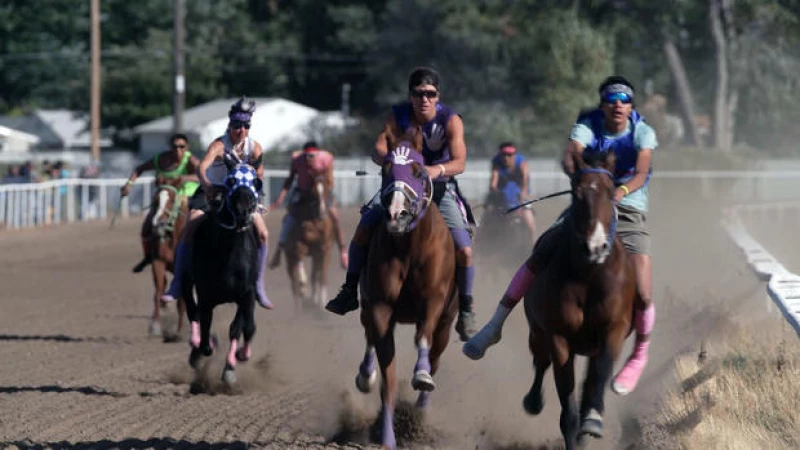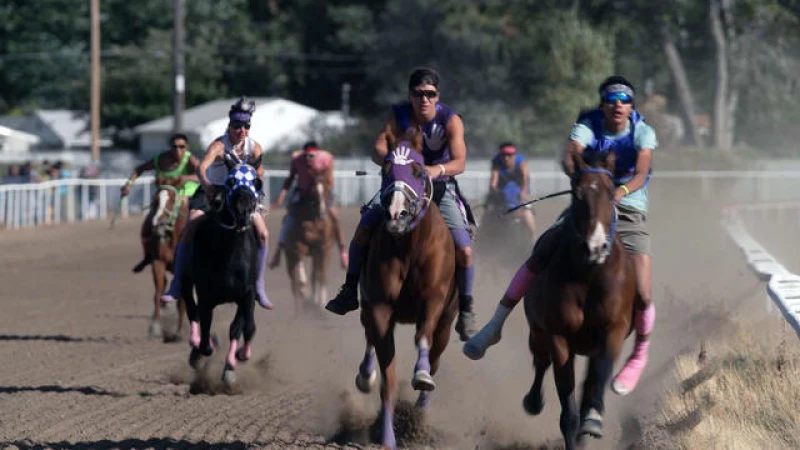Indian Relay, a race where riders risk collisions with thousand-pound horses, is both exhilarating and dangerous, but team manager Mason Red Wing says the connection with horses saved his life.
Red Wing grew up on the Crow Creek Sioux Reservation in South Dakota, angry at his own people. Native American communities suffer from high rates of substance abuse and Red Wing's own father succumbed to alcoholism. The horses Red Wing's team brings to Indian Relay races reconnected him with his culture and made him feel proud of who he is and where he's from.
"What the horse done for me, I know the horse can do that for everyone 1,000 times over," he said. "And I'm a firm believer in it. I know for a fact it can, it can bring our young men and our young women back."
What is Indian Relay?
Members of the Shoshone, Crow, Blackfeet, Sioux and other tribes of the Great Plains — collectively known as the Horse Nations — have relied on horses for hunting, battle and survival for centuries. Men, women and children from those tribes also use horses in a sport that fans have dubbed "America's original extreme sport."
Witness the intense spectacle of Indian Relay, where up to six thoroughbred racehorses line up at a dirt start line, their riders bareback and without any protective gear.
At the sound of a horn, the riders mount their horses and dash down the track. After completing the first lap, they swiftly switch to fresh horses in a thrilling exchange, requiring coordination between riders and teammates.
With each exchange, the riders leap onto new horses and gallop off for another lap, while their teammates manage the horses left behind. This intricate process involves six riders, 18 horses, 18 other individuals, and a cloud of dust swirling in their wake.
The exchange poses risks for both riders and teammates, with injuries being a common occurrence in this high-octane sport, as noted by race announcer Ken Real Bird.
While the men's division consists of three laps, the women's division only has two. In the children's division, young riders as little as 6 years old compete on ponies for three laps around a shorter course.
Exploring the Origins of Indian Relay
The origins of modern Indian Relay can be traced back to the horse-stealing raids carried out by tribes against White settlers and among themselves. Real Bird explained that during the middle of the night, raiding parties would seize prized horses and swiftly return to their homelands. As they fled, they would swap horses to outrun their pursuers, laying the foundation for the Indian Relay sport we see today.
Organized races in this sport began in the early 1900s, serving as a way to honor and connect with the warriors of the past. Real Bird emphasized that the competitors today carry the same warrior spirit in their bloodline as those from two centuries ago.

In its early days, Indian Relay races predominantly took place on reservations and within Native American communities. Calvin Ghost Bear, president of the Horse Nations Indian Relay Council and a member of the Sioux Tribe, highlighted the efforts of Horse Nations in bringing these races from tribal nations to a wider audience. The sport is now gaining traction on a larger stage, thanks to this expansion.
Indian Relay today
Last summer's Indian Relay circuit around the West culminated in Casper, Wyoming, with a three-day championship event that honored tribal culture through song, drumming, and dance. With over $100,000 in prize money at stake, sponsored by a casino owned by the Northern Arapahoe tribe.
Indian Relay is a sport characterized by hard work and dedication, devoid of glamour. Each team is self-supported, with most participants juggling the sport alongside their day jobs. However, the sport is gaining popularity, with an increase in prize money and the number of competing teams; 67 teams vied for victory in the previous summer's championships.
The caliber of horses in the competition is also on the rise. Teams now invest in thoroughbred speed horses from top racetracks, breeding them to excel in the Indian Relay format.
Ghost Bear envisions a future where Indian Relay reaches Churchill Downs, the renowned venue of the Kentucky Derby.
"Kentucky, that would be the ultimate," Ghost Bear expressed. "A demonstration race before the Derby, that would be my goal."







